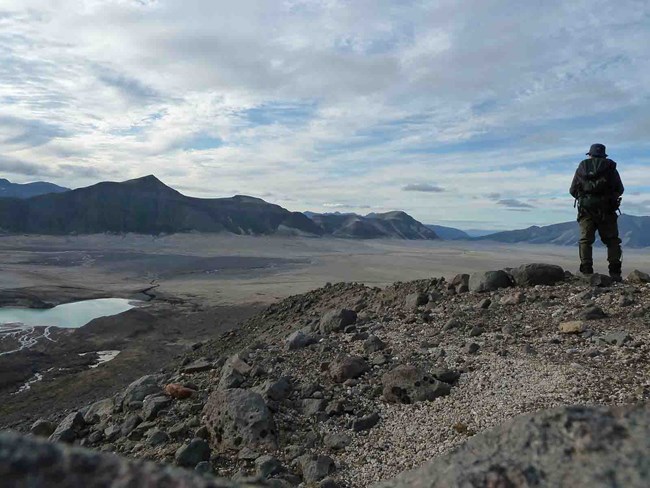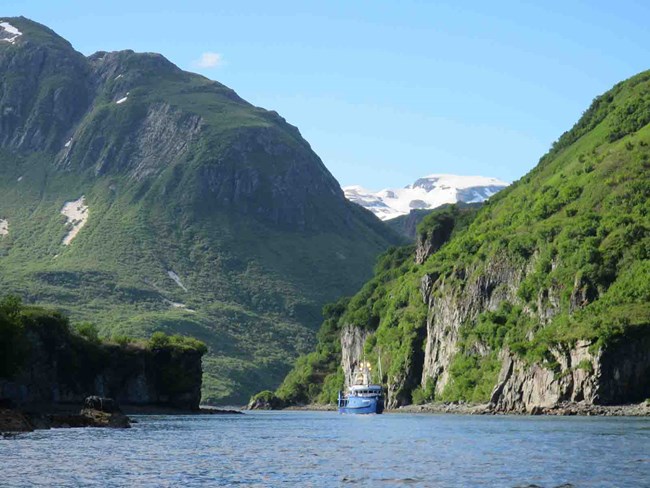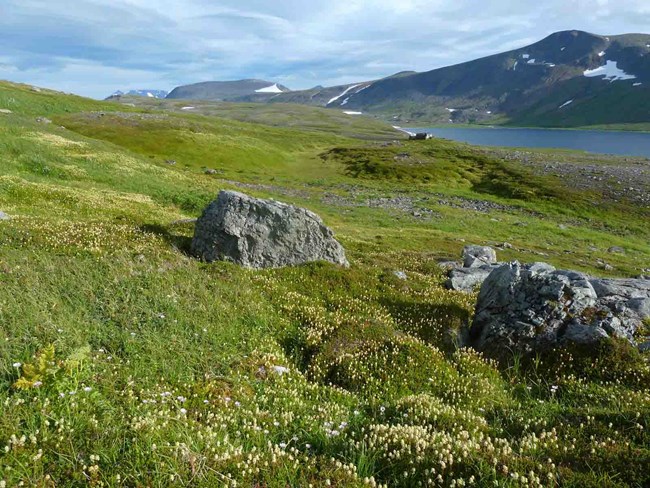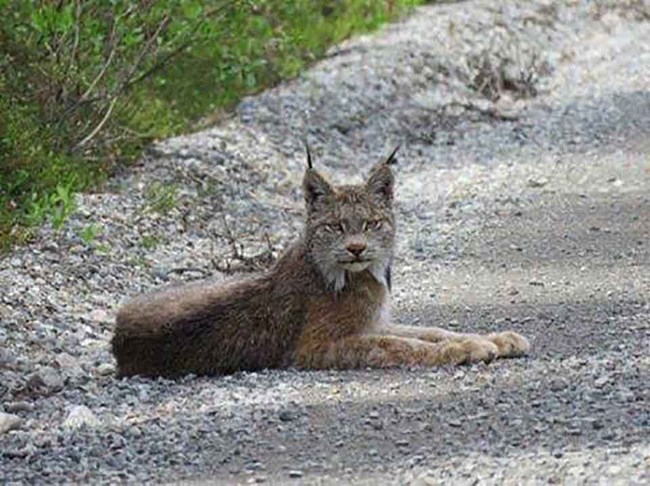
NPS/M. Fitz
Climate
The climate of the Alaska Peninsula and Katmai National Park and Preserve is influenced by storms originating in the North Pacific and moving along a storm track that parallels the Aleutian chain. Storm frequency is greatest between August and October, but local geographic conditions produce a variety of microclimates. High winds are common along the Shelikof Strait due to the funneling of air between Kodiak Island and the Aleutian Range. The Aleutian Range also forms a cloud barrier, creating orographic rainfall along the Shelikof coast and on the eastern flank of the Aleutian Range.
Geology
Katmai rests above a convergent plate margin, part of the circum-Pacific Ring of Fire, and one of the most active volcanic belts in the world. The 1912 eruption of Novarupta and subsequent caldera-forming collapse of Mt. Katmai are the most significant volcanic events occurring in historic times. Ash from Novarupta covered the adjacent valley to great depth, creating numerous fumaroles and thus the name, the Valley of Ten Thousand Smokes. Mt. Trident erupted in 1952, and minor ash eruptions and outbursts have also occurred on Mount Mageik, Mount Martin, Novarupta, and Mt. Katmai since the 1912 eruption.

NPS/Jim Pfeiffenberger
Coastal and Marine Resources
The coastline extends from the mouth of the Kamishak River in Kamishak Bay to Cape Kubugakli in Shelikof Strait, with 497 linear mi (800 km) of coast, including islands. The entire coastline has been shaped by glaciation, with long, narrow fjords and U-shaped valleys. Exposed bedrock and shallow soils prevail on headlands and islands. Typically, rivers enter at the heads of the fjords and are characterized by shorter, wider estuarine embayments. This complex ecosystem includes salt marshes, sandy beaches, island and sea stack bays, and rocky headlands.
Hydrology
Katmai extends across five river basins.
The Naknek, Kvichak, and Egegik river basins are on the western side of the Aleutian Range and drain into Bristol Bay. The North and South Coastal basins are on the eastern side of the Aleutian Range and drain into Cook Inlet and the Shelikof Strait, respectively.
The park contains the largest freshwater lake in the National Park System (Naknek Lake) and some of the largest lakes in Alaska. These lakes make up approximately 8% of the park’s surface area. Glaciers make up 6% (216,000 acres; 87,412 hectares) of the park. The hydrologic cycle in the park is influenced in part by extensive glaciers and snowfields that supply vast quantities of silty meltwater to headwaters during the summer months.

Flora and Fauna
Katmai is a young landscape, and the current vegetation reflects a patchwork of successional stages, from early seral communities in and around the Valley of Ten Thousand Smokes, to late seral forests in the Naknek and Coville-Grosvenor basins. In the interior of the park, low-elevation glacial moraines support white spruce and birch/balsam poplar forests with low and dwarf shrub communities dominated by wildflowers, heath, and berries in the understory and openings. The southernmost extent of white spruce on the Alaska Peninsula occurs just south of King Salmon and Lake Brooks, near Boundary Creek. Lacustrine deposits and old lake terraces west of Brooks and Naknek lakes are vegetated with sedge/low shrub tundra and open alder stands, while portions of the large west-flowing river valleys (Naknek, Nonvianuk) are covered by white spruce, with balsam poplar along the floodplains. Several valleys around Novarupta and Katmai, and slopes on the eastern side of the range, are still covered with deep ash deposits that remain unvegetated.
The Kejulik and Cape Douglas mountains are permanently glaciated, with valley glaciers nearly reaching the Shelikof coast. Below barren, exposed ridgetops and outcrops, patches of alpine tundra and low shrubs find footholds in sheltered niches and shallower patches of ash from the 1912 eruption. Lower slopes support dense alder stands, with a few Sitka spruce on the coastal headlands. To the north, the Walatka Mountains and Kamishak highlands support dwarf shrub and alpine tundras at higher elevations, with dense alder on lower slopes and cottonwood stands along the streams in the lowest valleys.
Expansive and highly productive salt marshes, brackish meadows, and wetlands occupy portions of the northern coast. Hallo Bay and Swikshak Bay support large populations of brown bears that attract photographers and bear viewers. The southern coast is characterized by rocky bays and inlets with dense alder thickets on the lower slopes. The coast supports a large diversity of seabirds and sea ducks as well as providing ample habitat to a large population of sea otters. Haulouts for harbor seals and sea lions dot the coast and a variety of cetaceans can be observed just offshore.

NPS/Tammy Carmack
Thirty-five terrestrial mammal species are documented or are expected to occur in the park. Commonly observed species include brown bear, moose, caribou, red fox, ermine, mink, porcupine, beaver, Alaskan hare, snowshoe hare, red squirrel, Arctic ground squirrel, northern red-backed vole, and little brown bat. Species less frequently observed include wolf, coyote, lynx, river otter, wolverine, and marten.
Species of anadromous Pacific salmon include sockeye (red), chinook (king), coho (silver), chum (dog), and pink (humpy). Rainbow trout is the only species of trout known to occur in the park. Species of char include lake trout, Arctic char, and Dolly Varden. Whitefish are well represented, with round, pygmy, broad, and humpback whitefish, as well as least cisco. Arctic grayling are also present in the park.
Sea otters (a federally listed threatened species in southwest Alaska), harbor seals, and Steller sea lions occur along most of the coastline. The park’s coastal waters are relatively shallow, creating habitat for clam species that support a high density of sea otters and benthic foraging sea ducks. Beluga whales, fin whales, and humpback whales also regularly occur offshore and in bays.
About 180 bird species are documented or expected to occur within the park, including 81 landbird species, 64 inland waterbird species, and 35 seabird species. Federal bird species of concern that occur in terrestrial areas of the park include the Harlequin Duck and Olive-sided Flycatcher. American Peregrine Falcon, Black Oystercatcher, Olive-sided Flycatcher, Gray-cheeked Thrush, and Blackpoll Warbler are State of Alaska species of special concern that have been documented or are thought to occur in the park.
What's Happening in Katmai National Park and Preserve
Last updated: December 8, 2025
